How to Create Your Own Fake Japanese Food Souvenir in Tokyo
Did you know one of the things Japan is known for is sampuru? Translating to “sample,” these realistic displays of fake Japanese food out front of restaurants and cafés are so genuine in fact, at a quick first glance you’d be forgiven for thinking they were real!
There is an abundance of attention to detail embedded in Japanese cuisine: Overload of flavours; immaculate presentation; unique and contrasting textures. Interestingly, I was about to learn that the same sharp attention is afforded to fake food, too.
Since I love ramen and had just experienced a ramen tasting tour in Shibuya, without hesitation jumped at the chance to make my very own Japanese plastic food replica right in Tokyo to bring home.

If you’ve ever wondered how fake plastic food is made in Japan, how you can create your own, and what to expect at a workshop in one of the country’s top sampuru factories, read on for more!
This Japanese replica food class was kindly sponsored by Klook. As always, all thoughts and opinions are my own. This post contains affiliate links. I may earn a small commission if you click through and make a purchase.
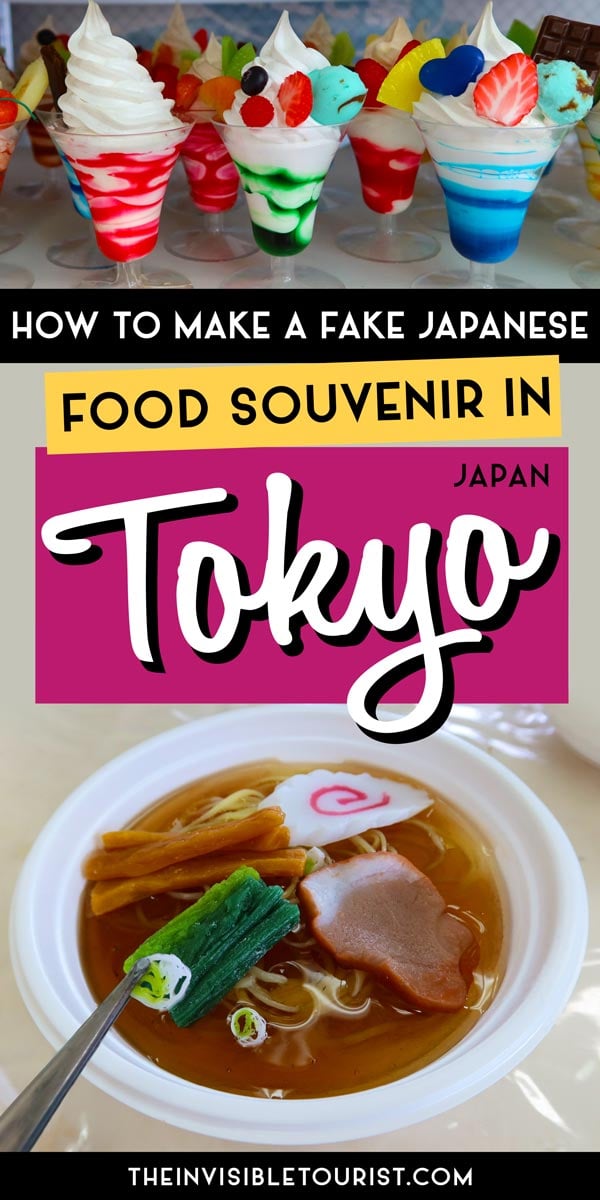
Types of Japanese cultural experiences with Klook
I undertook this fun fake food making in Tokyo through popular travel booking platform Klook. As well as being able to purchase discounted transport passes (such as the Japan Rail Pass, Tokyo Subway Pass and Suica Cards), you can use Klook to book hundreds of cultural experiences in Japan to enrich your trip!
Here are some more Japan experiences through Klook:
- Enjoy a tea ceremony by Mt Fuji (read my full review of this Tokyo to Mt Fuji day trip)
- Witness Tokyo from above at Shibuya Sky (read my tips for visiting Shibuya Sky for the perfect experience)
- Give new life to broken items by repairing them with gold at a kintsugi class in Tokyo
- Visit temples and shrines while wearing a kimono or yukata in Tokyo for a day
- Have fun at a sumo wrestling experience and enjoy a chanko lunch
- Combine several attractions and save up to 62% with the Klook Tokyo Fun Pass
- You can also pre-book pocket wifi to stay connected during your trip. Read my tips for renting portable wifi in Japan for details!
Quick Q&A about fake food in Japan
What is Japanese fake food called?
Japanese fake foods are known as sampuru サンプル, which translates to “sample.” More specifically, they can be called 食品 サンプル, which means shokuhin sampuru or “food sample.”
What is Japanese fake food made of?
Plastic, vinyls and wax are most commonly used to make Japanese fake food.
Wax was more popular during the early Showa Era (1926 – 1989), however it was later realised in time some waxes would melt. Today, plastics and vinyls are used to help the longevity of the sampuru.
Why do Japanese restaurants have plastic food?
Instead of menus, Japanese restaurants use plastic food to help customers decide what to order by knowing what to expect.
The idea of replica display food originated during the early Showa era. As street food stalls were usually very crowded at the time, having these samples on display would help customers to decide their order before reaching the counter. We love efficiency!
Real food would obviously deteriorate throughout the day, but a sample represented exactly what customers could expect. This sampuru culture first began in Gujo Hachiman, Gifu Prefecture, its popularity then spreading throughout Japan.
TIP: You can read my full Gujo Hachiman day trip itinerary from Nagoya for more!

How to make Japanese fake food: Creating a sampuru ramen bowl in Tokyo
Now for the part you’ve been waiting for – the Japanese fake food making! I’ve made a quick little video of this experience on my Instagram.
On arriving at the workshop, I was greeted by Ito-san. He has been working in the replica food industry for a number of years and is a master of his craft!
As I sat at my table, all the pieces and tools I was going to need were laid out in front of me. A plastic bowl of ramen was there to inspire my finished product.
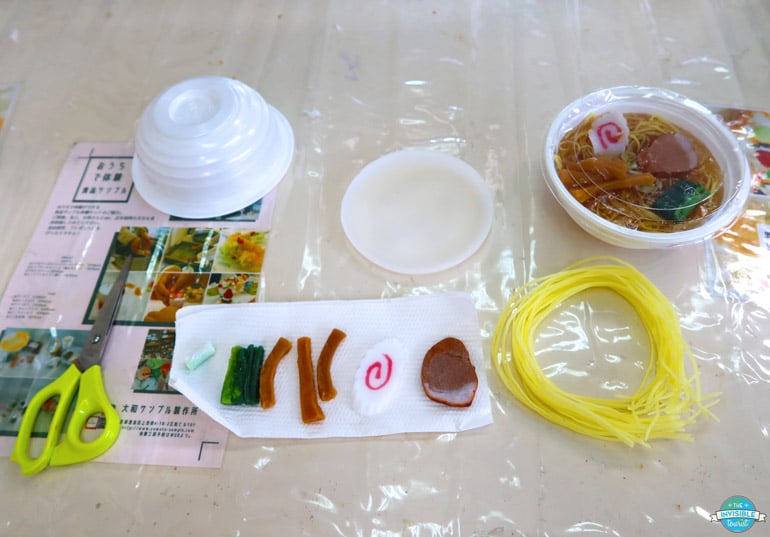
The first step was to soften up the wax pieces in warm water for a few minutes, before adding the noodles. Due to their thin nature, the noodles warmed and softened quite quickly!

Next, I had to curl the thin noodles into a swirl-like shape. Here I realised I needed to work quickly as the noodles cooled and hardened again in a very short time. By wrapping the noodles around my fingers I was able to achieve the desired swirls like the sample bowl.
TIP: It is harder than it looks to not get square edges as the noodles cooled rapidly once out of the warm water!
As I swirled each bunch of noodles, I added them to a wax finishing plate that would be placed in the bowl once finished.

|
Sound good so far?
|
By this time, it was the moment to take out the chunkier wax pieces from the water and dry them on a paper towel. While they were still warm and mouldable, I was able to bend the pieces to make their shape more realistic.
Ito-san showed me how to place the swirled wax noodles into the finishing bowl, then presented me with a cup of hot, clear wax to pour over the swirled noodles to hold them in place.
As the clear wax cooled, I cut the spring onion shoot to have the pieces ready for placement.
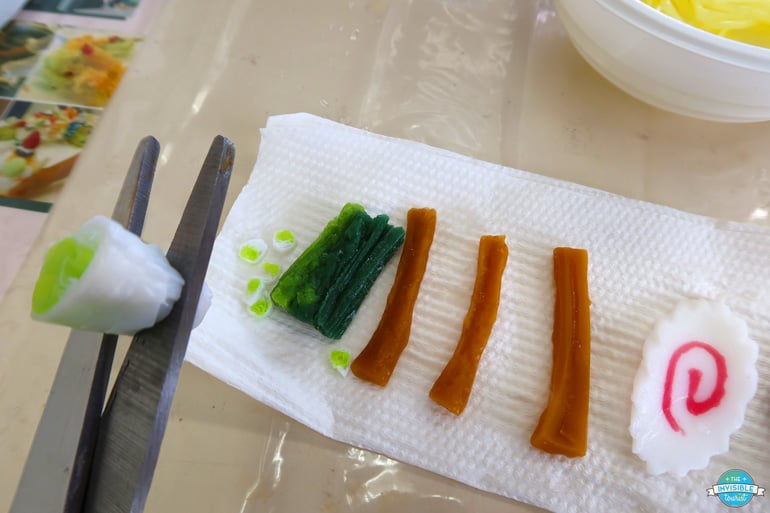
Ito-san then proceeded to warm up a sticky, gelatin-like brown liquid to pour over the noodles that represented the ramen broth. Then, slowly and carefully pouring the hot liquid over the noodles, he helped to ensure the setting liquid was evenly spread and level.
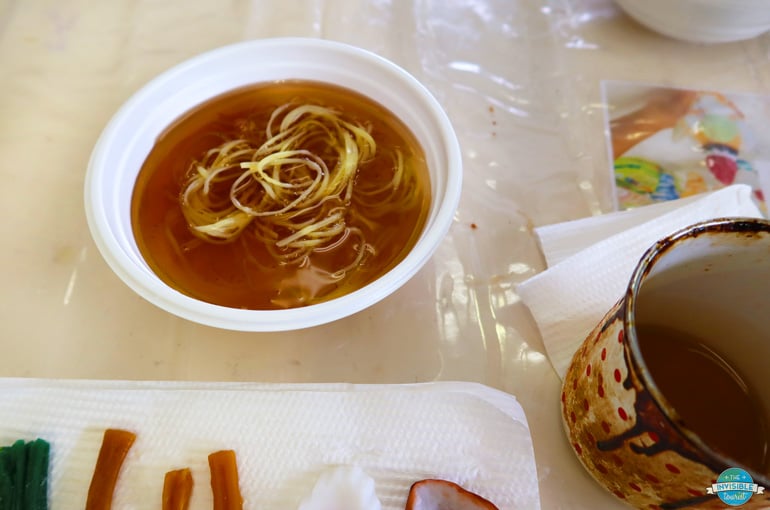
Now for the creative part where it was time to add the topping ingredients to the noodles! I spent a few moments figuring out how I wanted the layout of my pieces to look.
The spring onion pieces I had cut were so small I used tweezers to individually place them in the bowl. Once all the pieces were in, Ito-san showed me where to pour the remaining sticky liquid to make sure all my pieces were adhered properly.

And then, voilà! My fake Japanese food was now complete. How do you think I went? I was pretty happy with how it turned out!
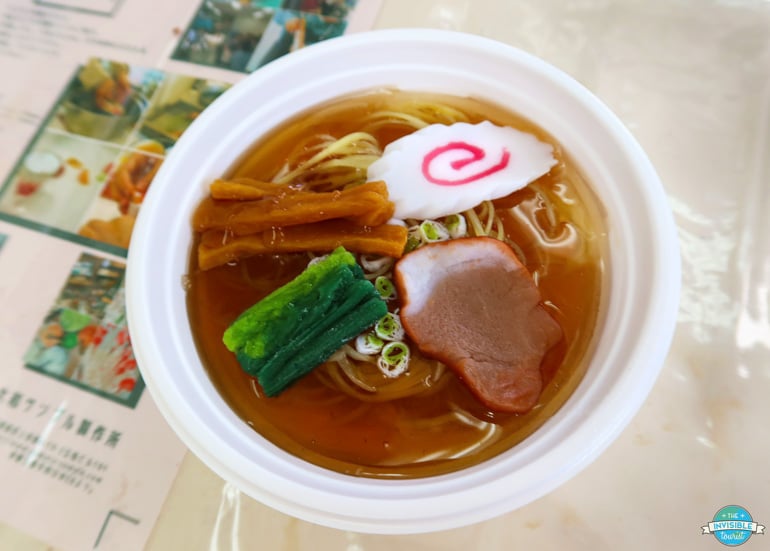
TIP: All up, the experience lasted for an hour. After my bowl had set, Ito-san gave me a sturdy box so it wouldn’t get damaged in my suitcase back to Australia.
Be surprised by the Japanese fake food display
While your food model sets, check out the other plastic food models and dishes on display in the shop. From rice to pastries, fish to spaghetti, roast chicken to popcorn, soft drinks to sushi and more. I was most surprised by the orange peel, it even felt just like the real thing!
If you’re looking for unique souvenirs from Japan as gifts, the macaron and parfait keyrings, cell phone charms, jewellery, fridge magnets and more are sure to be great conversation starters.
Just look at how amazing these desserts are. I have to admit I had a hard time choosing between making the ramen or parfait ice creams!
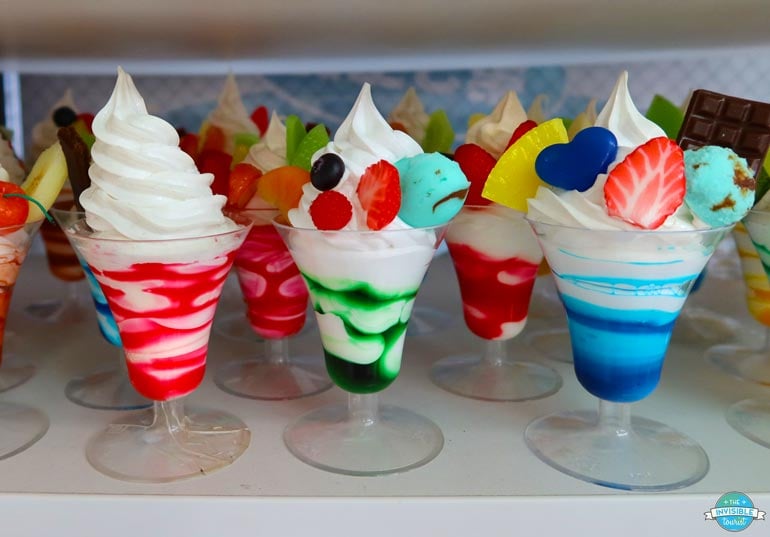
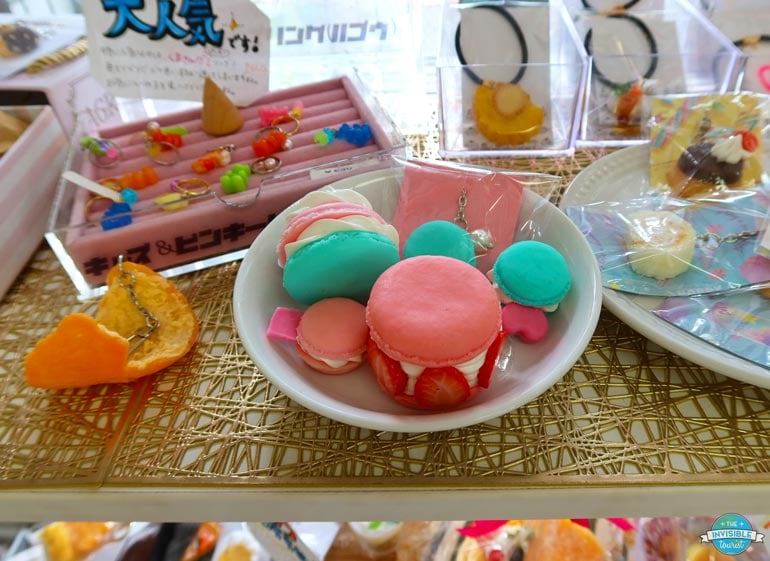
TIP: I’ve rounded up the many and best food tours in Tokyo I’ve enjoyed and highly recommend you add to your itinerary!
Concluding this Japanese plastic food-making experience
Now you know what goes into making sampuru fake foods, keep your eye out for them at Japanese restaurants during your travels!
I found the history and reasoning behind sampuru quite interesting, and love how this practice has become firmly engrained within Japanese culture over the decades.
What do you think of Japanese replica food? Do you find it as cool and as impressive as I do? I’d love to hear if this sampuru Tokyo experience is on your Japan bucket list someday, so let me know in the comments below.
Sending a big thanks again to Klook for kindly sponsoring this experience!
While you’re here, why not take a look at my itineraries for 2 weeks or 3 weeks in Japan to help plan your trip, do’s and don’ts of Japanese etiquette, learn some basic Japanese phrases for tourists with my free cheat sheet, find out what to pack for Japan, and even the best Japanese souvenirs to bring home – I have every step of your Japan planning journey covered from my multiple visits!
Feeling social? Come and join me on Facebook, Pinterest, TikTok and Instagram for more Japan travel inspiration!
Until next time,

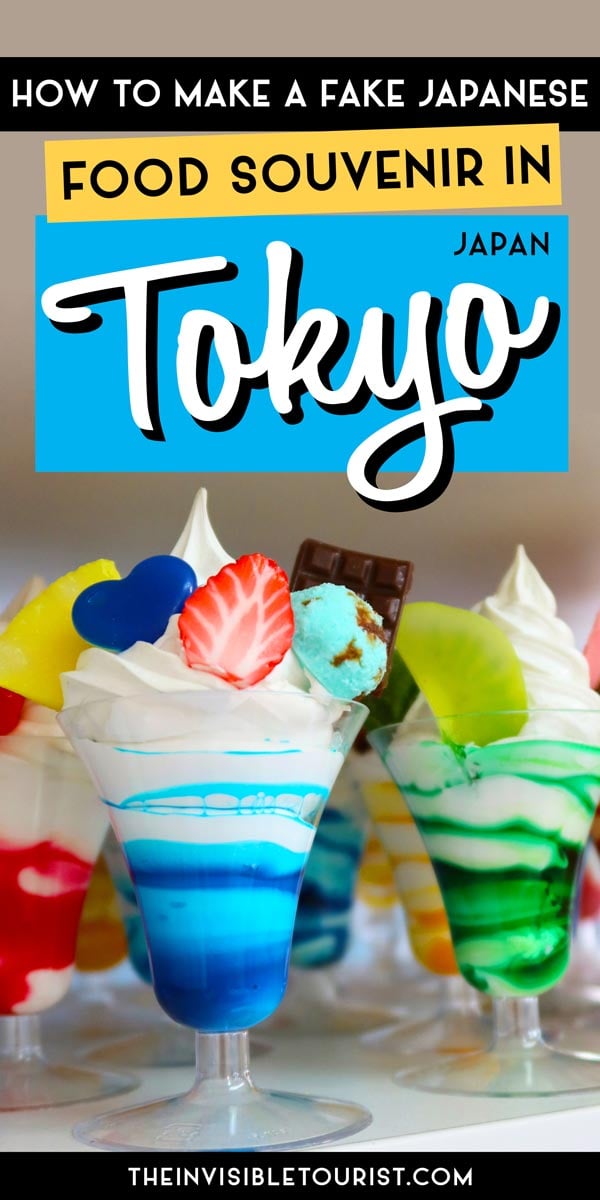
This guide to creating fake Japanese food contains some affiliate links, at no extra cost to you. I may earn a small commission if you decide to make a purchase and if you do, thanks for your support! This helps with the costs of running my blog so I can keep my content free for you. As always, I only recommend a product or service that I genuinely love and use myself!
